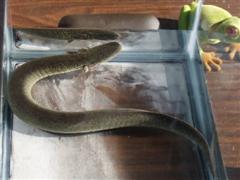Salamander - Greater Siren
Scientific Name: Siren lacertina
Sat, 5th July, 2025 - 10:08 pm GMT

Alternative Name
Scientific Name: Siren lacertinaBasic Info
Because they lack hind legs, the appearance of the Greater Siren is unique. They have long, thick bodies and are usually between two and a half and three feet long. The Greater Siren is a drab olive green or gray to black color. The sides can have some sort of marking, often lines, spots, or blotches of lighter colors. The belly of the Greater Siren is generally a lighter shade than the rest of its body, and may have yellow-green or light green markings. Immature Greater Sirens have light stripes along the sides of their body that disappear as the animal ages. The forelimbs of the Greater Siren both have four distinct fingers, though the gills may obscure these limbs. More than 36 costal grooves are usually present, and the external gills that the Greater Siren uses to breathe are quite obvious. The tails of Greater Sirens may have fin-like structures around the edges, and are flattened laterally.
Health
Breeding a Greater Sirens usually reach sexual maturity between two and three years of age. They lay their eggs in the late winter through the spring. Usually, larvae will hatch out of the eggs in about two months.Habitat
Generally, Greater Sirens are found in wet or muddy areas like ditches filled with water, ponds, lakes, or even moving waters like streams or bays. Usually, it prefers areas of shallow waters that are thickly grown with plants.Behavior
The Greater Siren is a legless salamander! Because it cannot move on land, it can secrete a substance around its body, in dry seasons, which will allow it to survive in mud until water is again available. Generally, Greater Sirens are hidden during the day underneath submerged logs or other bottom debris. At night, the Greater Siren comes out to hunt. It eats aquatic animals like crayfish, or invertebrates. When the body of water it is living in dries out, the Greater Siren can aestivate. It buries itself in mud at the bottom of its habitat, and a cocoon of shed skin and mucous is secreted to protect and envelop its body. The Greater Siren's body functions slow, and it can survive in this manner for several months until water once again fills the area in which it lives.Origin
Southern United StatesHistory
Usually, Greater Sirens are found throughout the lower coastal plains of North America. They can tolerate brackish water and can also tolerate drought by aestivating. Although the Greater Siren is not common in many areas, it can be quite populous in isolated areas and is not thought to be threatened. It does face danger from aquatic herbicides, in addition to the draining of many wetland areas. In order to observe Greater Sirens in the wild, it may be best to try to see them at night with the aid of a flashlight.Common Foods
feeds primarily on insects, earthworms, small rodents, small animals."After these matters we ought perhaps next to discuss pleasure. For it is thought to be most intimately connected with our human nature, which is the reason why in educating the young we steer them by the rudders of pleasure and pain; it is thought, too, that to enjoy the things we ought and to hate the things we ought has the greatest bearing on virtue of character. For these things extend right through life, with a weight and power of their own in respect both to virtue and to the happy life, since men choose what is pleasant and avoid what is painful; and such things, it will be thought, we should least of all omit to discuss, especially since they admit of much dispute." -- Aristotle. Nicomachean Ethics. (X.1172a17). c. 325 BC.
Salamander - Greater Siren
Coded by: BGID® | ALL RIGHTS RESERVED Copyright © 2000-2025
Disclaimer | Privacy | Report Errors / Contact | Credits








 Why haven't we as a collective earth met with aliens yet?
Why haven't we as a collective earth met with aliens yet?  World EcoSystem - Biodiversity Changes - Who is on board and who isn
World EcoSystem - Biodiversity Changes - Who is on board and who isn  Homosexual behavior stems from the mind or genetics?
Homosexual behavior stems from the mind or genetics?  The Best Text Adventure You Will Ever Play! The official site:
The Best Text Adventure You Will Ever Play! The official site:  Mouthwash - Mouthrinse - Mouth Sores - Healing Infections - Gingivitis
Mouthwash - Mouthrinse - Mouth Sores - Healing Infections - Gingivitis  Treatment for Depression
Treatment for Depression  Ultra radical and violent Islamist group that even rivals Al Qaeda
Ultra radical and violent Islamist group that even rivals Al Qaeda  An idea to have teachers who want to carry guns to school undergo some level of police training will be left up to local school districts and police departments.
An idea to have teachers who want to carry guns to school undergo some level of police training will be left up to local school districts and police departments.